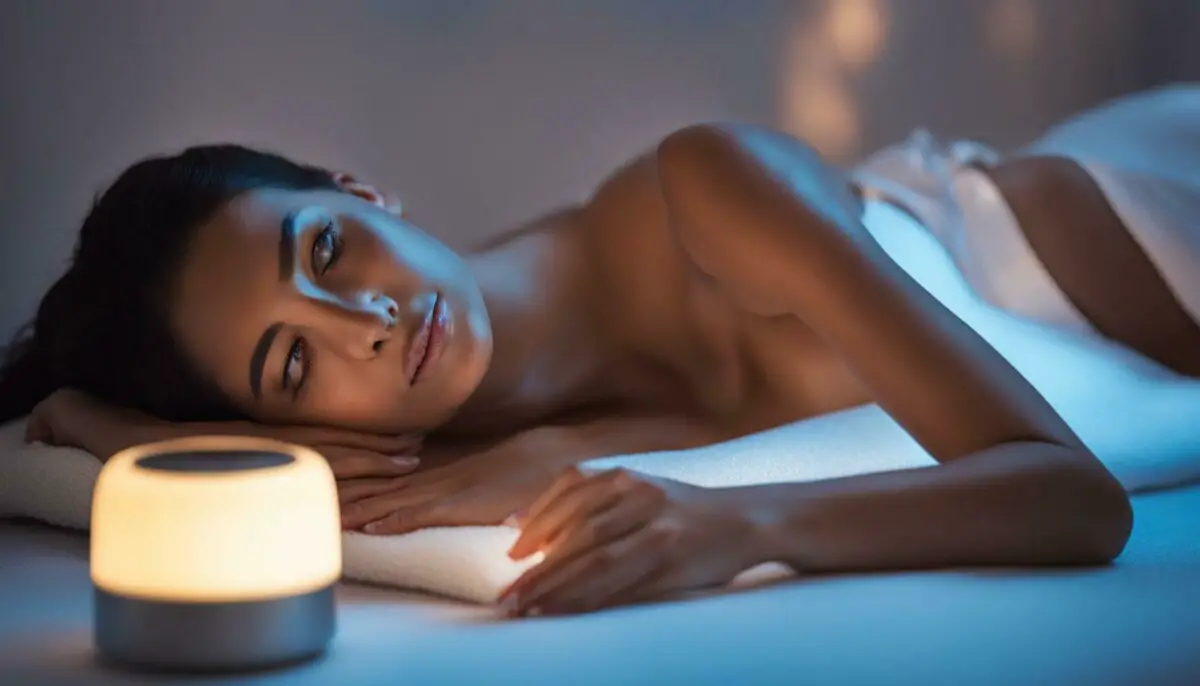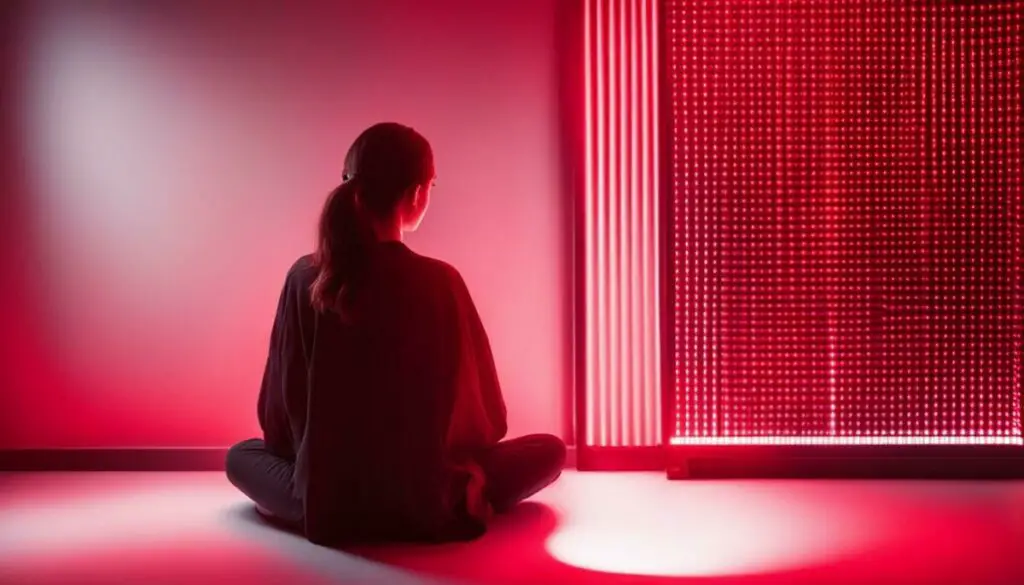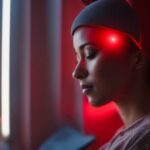Last Updated on 6 months by Francis
Light therapy has gained popularity in recent years as a non-invasive and effective way to promote skincare, improve sleep quality, alleviate pain, and boost hair growth. There are two primary types of light therapy: blue light therapy and red light therapy. While both therapies have shown promising results, it’s essential to understand their unique benefits to determine which one is the best choice for your specific needs.
In this article, we will explore the benefits of blue light therapy and red light therapy, discussing their uses for various skincare and health needs. By the end, you’ll have a clearer understanding of which therapy is the superior choice for you.
Contents
Key Takeaways
- Light therapy offers non-invasive and effective solutions for skincare, sleep, pain relief, and hair growth.
- Blue light therapy and red light therapy are the two primary types of light therapy.
- Each therapy has unique benefits and applications for various health and skincare concerns.
- Determining the best therapy for you depends on your specific needs and goals.
- By the end of this article, you’ll have a clearer understanding of the benefits and applications of both blue light therapy and red light therapy.
Understanding Blue Light Therapy
Are you considering blue light therapy for your skincare needs or to improve your sleep quality? Blue light therapy is a non-invasive treatment that involves exposing the skin to specific wavelengths of blue light to target various skin concerns and improve sleep quality.
The treatment is thought to work by stimulating the production of new collagen in the skin, reducing inflammation and killing acne-causing bacteria.
Some of the benefits of blue light therapy for skin include:
- Reducing acne breakouts
- Minimizing the appearance of pores
- Improving skin texture and tone
Additionally, blue light therapy has shown potential in addressing sleep disorders such as insomnia and improving sleep quality. The exposure to blue light is thought to suppress melatonin production, which can help regulate the sleep-wake cycle.
Other potential benefits of blue light therapy include:
- Increasing energy and alertness
- Boosting mood and reducing symptoms of depression
- Helping to regulate circadian rhythms and reduce jet lag
- Improving visual performance and reducing eye strain
If you’re considering blue light therapy for your sleep needs, it’s important to note that the treatment should be avoided before bedtime as the exposure to blue light can interfere with the production of melatonin.
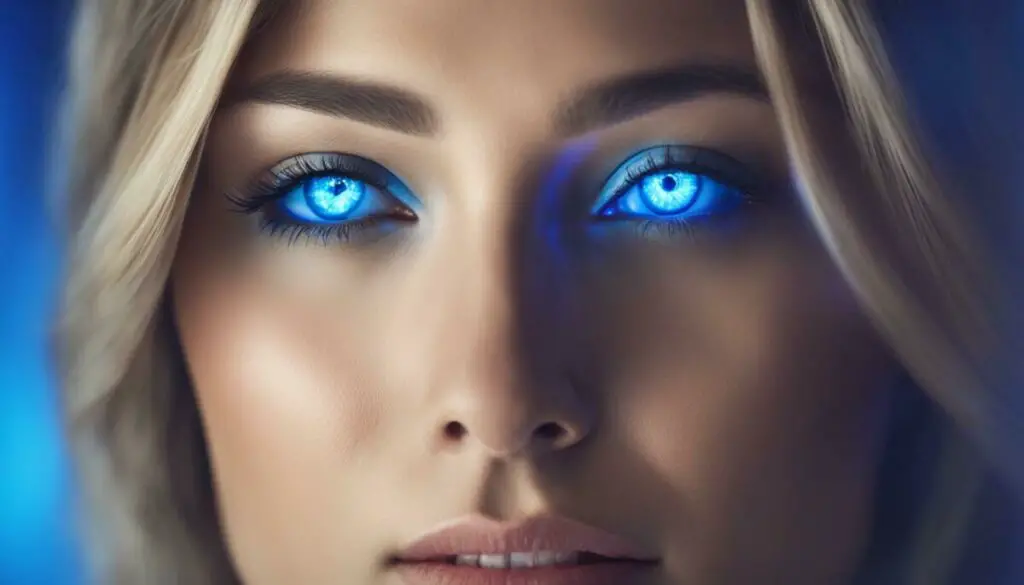
Blue light therapy for eyes has also gained attention for its potential in promoting eye health and reducing the risk of age-related macular degeneration. The treatment involves exposing the eyes to specific wavelengths of blue light, improving visual performance and reducing eye strain.
Overall, blue light therapy has shown promising results for various health concerns. In the next section, we will explore the mechanisms and benefits of red light therapy, allowing you to make an informed choice between the two therapies.
Exploring Red Light Therapy
Red light therapy is a form of light therapy that uses specific wavelengths of red light to provide a range of skincare and health benefits. The therapy works by penetrating deep into the skin layers, stimulating the production of collagen, elastin, and other vital proteins. These proteins are crucial for maintaining healthy, youthful-looking skin.
Red light therapy is commonly used for skin rejuvenation, to reduce the appearance of fine lines, wrinkles, and sun damage. The therapy can also promote wound healing, improve circulation, and reduce inflammation, making it an effective treatment for acne, rosacea, and eczema.
One of the lesser-known benefits of red light therapy is its ability to stimulate hair growth. The therapy can help increase circulation in the scalp, which can promote hair growth and thickness. Many studies have shown promising results in using red light therapy for hair regrowth.
Another potential benefit of red light therapy is pain relief. The therapy can help reduce inflammation and promote healing, making it a useful treatment for chronic pain conditions such as arthritis, fibromyalgia, and back pain.
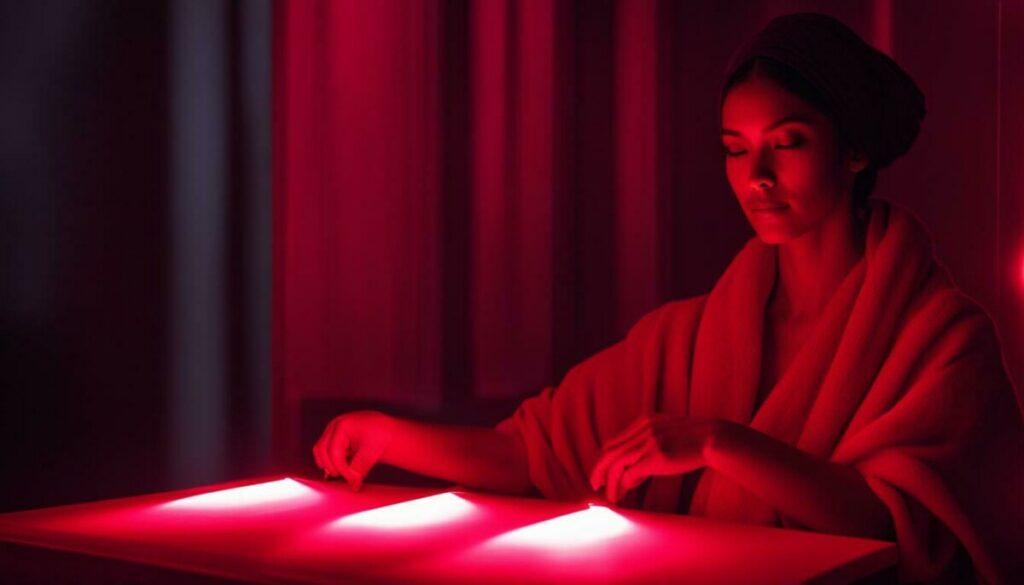
Overall, red light therapy offers a range of benefits for both the skin and the body. Its ability to stimulate collagen production, reduce inflammation, and promote healing makes it a valuable tool for maintaining overall health and well-being.
Comparing the Benefits of Blue Light Therapy and Red Light Therapy
While both blue light therapy and red light therapy offer a range of health benefits, they have different applications and mechanisms of action.
Blue light therapy is effective in treating acne and other skin concerns, as it can penetrate the skin’s deeper layers and kill acne-causing bacteria. It can also improve sleep quality by regulating the body’s natural circadian rhythm and reducing blue light exposure before bedtime. Furthermore, blue light therapy can help protect the eyes from potential damage caused by excessive blue light exposure.
Red light therapy, on the other hand, can effectively promote hair growth by stimulating blood flow to the hair follicles and increasing cellular activity. It can also help alleviate pain and inflammation by reducing oxidative stress and promoting the body’s natural healing processes. Red light therapy may also be effective in managing mood disorders such as depression.
When it comes to skincare, both therapies can be effective in targeting acne and other skin concerns, although blue light therapy may be more suitable for individuals with oily or acne-prone skin. Red light therapy may be more effective in managing pain and inflammation, making it a popular choice among athletes and individuals with chronic pain.
Ultimately, the choice between blue light therapy and red light therapy depends on your specific needs and goals. It’s important to consult with a healthcare professional before starting any light therapy regimen to ensure that it’s safe and effective for you.
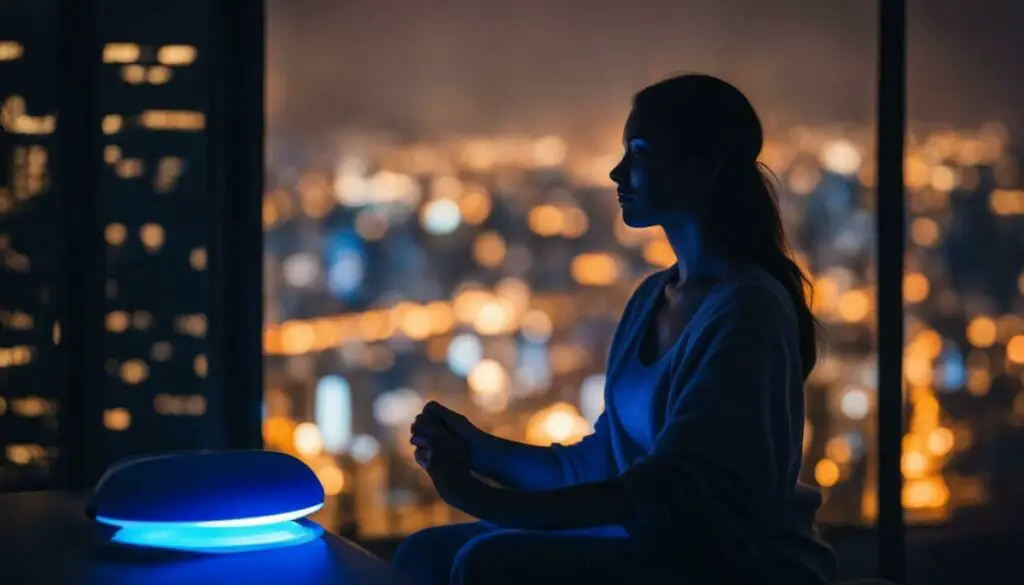
“Both blue light therapy and red light therapy offer unique benefits for various health needs. Understanding their applications and mechanisms of action can help you decide which one is right for you.”
Choosing the Right Therapy for Skincare
When it comes to achieving healthier skin, blue light therapy and red light therapy are both viable options. The right choice depends on your specific skin concerns and goals.
Blue light therapy: This therapy is effective for treating mild to moderate acne by killing the bacteria that cause breakouts. It can also reduce inflammation, leading to clearer, healthier skin. If your primary skincare concern is acne, blue light therapy may be the best choice.
Red light therapy: If you’re looking to reduce fine lines and wrinkles or improve skin texture and tone, red light therapy may be the way to go. This therapy boosts collagen production, which can make the skin look more youthful and radiant. It can also help improve scarring and hyperpigmentation, making it a great option for those concerned with these issues.
Ultimately, the choice between blue light therapy and red light therapy depends on your specific skin concerns and goals. Consult with a skincare professional to determine which therapy is best suited for your needs.

Precautions:
While both blue light therapy and red light therapy are generally safe, there are some precautions to keep in mind. Blue light therapy can cause temporary dryness, redness, and mild swelling, while red light therapy may cause mild heat and a tingling sensation. Both therapies should be used in moderation to avoid overexposure. Consult with your doctor or dermatologist before starting any light therapy treatment to ensure it is safe for you.
Enhancing Sleep Quality with Light Therapy
Are you one of those who struggle to fall asleep at night? Do you feel tired and groggy throughout the day due to poor sleep quality? If yes, then light therapy may be the answer to your sleep problems!
Both blue light therapy and red light therapy have shown potential in improving sleep quality. According to research, exposure to bright blue light in the morning can help regulate your circadian rhythm, making it easier to fall asleep at night. On the other hand, red light therapy promotes relaxation and has a soothing effect on the mind and body, making it an effective sleep aid.
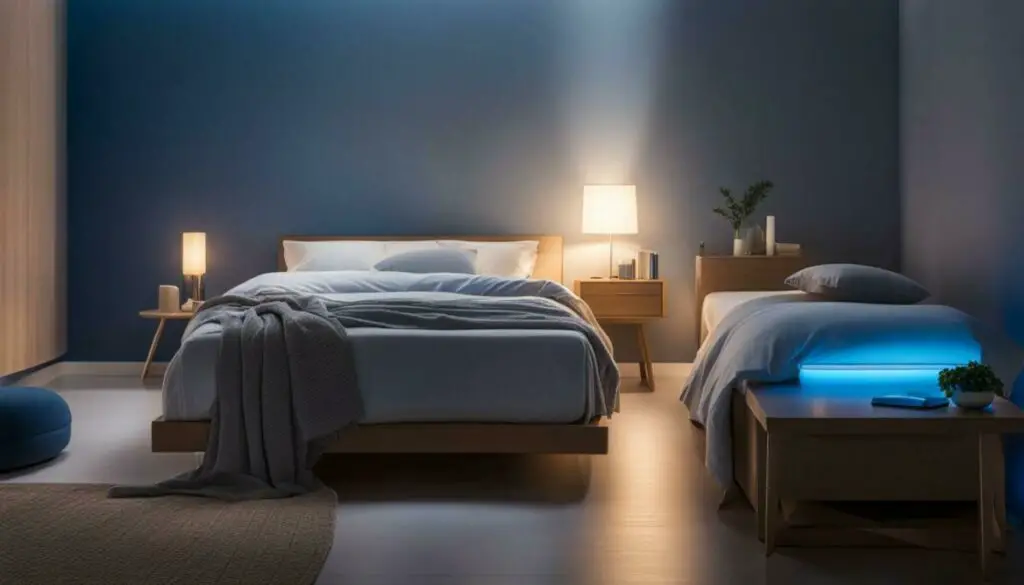
If you’re confused about which therapy to choose, consider your sleep-related needs. If you have difficulty falling asleep due to a disrupted circadian rhythm, blue light therapy might be a suitable choice. However, if you have trouble relaxing and calming your mind, red light therapy may be more effective in helping you achieve a good night’s sleep.
It’s important to note that light therapy should be used appropriately and at the right time of day. Consult with your healthcare provider to determine the best approach for your specific sleep concerns.
Hair Growth Stimulation: Blue Light vs. Red Light Therapy
If you’re looking to promote hair growth, both blue light therapy and red light therapy have been shown to be effective. Blue light therapy works by stimulating the hair follicles’ metabolism and increasing blood flow to the scalp, while red light therapy promotes cell growth and regeneration.
Research indicates that red light therapy is more effective in stimulating hair growth, as it penetrates deeper into the skin and promotes collagen production. However, blue light therapy may be a suitable alternative for individuals with sensitive or thinning hair.

Both therapies are non-invasive and free of side effects, making them a popular choice for hair regrowth. It’s important to note that hair growth stimulation may take time and consistency with therapy use.
Consult with a healthcare professional or a licensed dermatologist to determine which therapy is the best fit for your specific needs.
Targeted Eye Health: Blue Light Therapy
Electronic devices have become an integral part of modern life. However, the blue light emitted by these devices can lead to eye strain, digital eye fatigue, and other vision problems. Blue light therapy has emerged as a potential solution to these issues, utilizing specific wavelengths of blue light to alleviate eye strain and improve visual acuity.
Blue light therapy works by stimulating the production of melanopsin, a photopigment that regulates the body’s circadian rhythm and pupillary reflex. This can help to regulate sleep-wake cycles and promote better sleep quality, as well as reduce the risk of macular degeneration and other vision-related conditions.
Research suggests that blue light therapy may be particularly beneficial for individuals at risk of developing age-related macular degeneration (AMD), a condition that causes progressive damage to the macula, the part of the eye responsible for central vision. Blue light therapy can help to protect the macula from excessive blue light exposure, slowing the progression of AMD and preserving visual function.
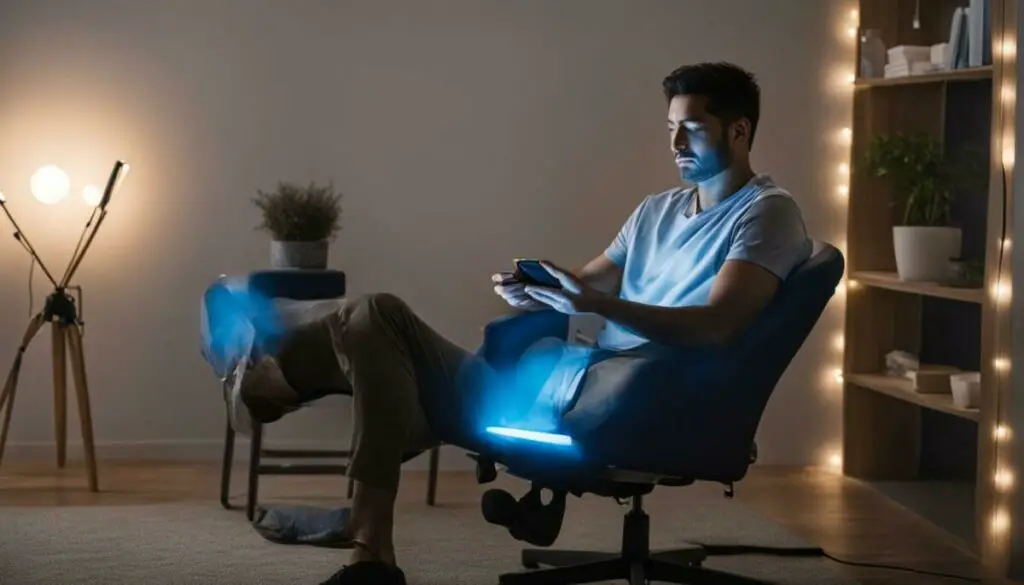
However, it’s important to note that excessive or prolonged exposure to blue light can also have detrimental effects on eye health. It’s essential to use blue light therapy devices as directed and to take regular breaks from electronic screens to avoid eye strain and fatigue.
If you’re interested in incorporating blue light therapy into your eye care routine, consult with an eye care professional to determine the appropriate treatment plan for your specific needs.
Pain Relief Potential: Red Light Therapy
If you suffer from chronic or acute pain, red light therapy may offer a natural alternative to pain relief medications. Research suggests that red light therapy can help reduce pain, inflammation, and swelling by increasing blood circulation and promoting the release of endorphins, the body’s natural painkillers.
Red light therapy has been clinically studied for its effectiveness in managing various types of pain, including:
| Pain Condition | Study Findings |
|---|---|
| Arthritis | Red light therapy significantly reduced joint pain and stiffness, and improved range of motion in patients with osteoarthritis and rheumatoid arthritis. (Source: Pain Research and Management) |
| Fibromyalgia | Red light therapy improved overall pain, increased function, and reduced tender points in patients with fibromyalgia. (Source: Journal of Physical Therapy Science) |
| Back Pain | Red light therapy reduced pain intensity and improved mobility in patients with chronic low back pain. (Source: The Clinical Journal of Pain) |
Red light therapy is a non-invasive and drug-free treatment option that may help relieve pain without the risks of addiction or side effects associated with pain medications.
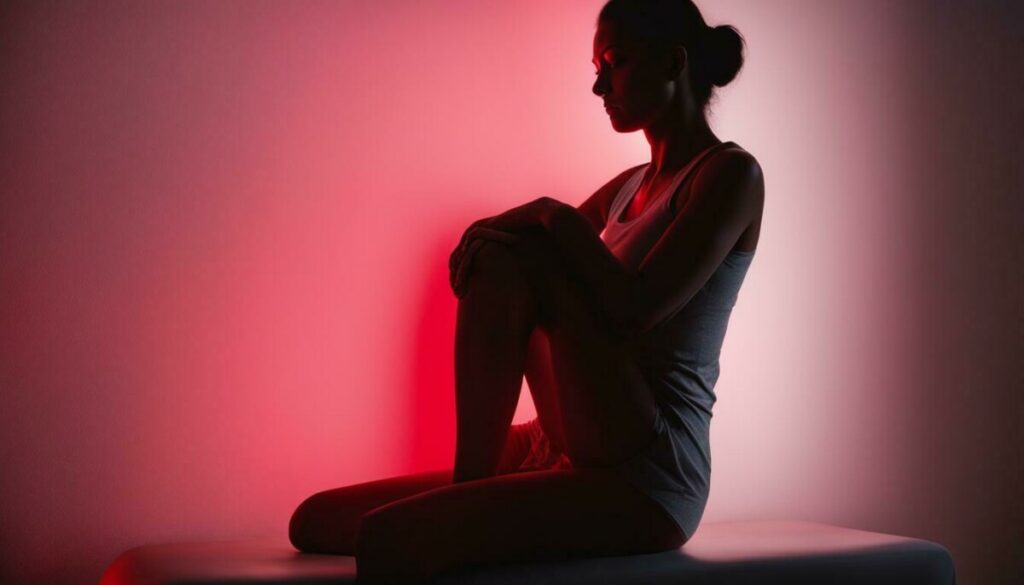
If you’re considering red light therapy for pain relief, it’s important to consult with your healthcare provider first. They can help determine the best course of treatment and ensure that red light therapy is safe and appropriate for your specific condition.
Choosing the Right Therapy for Skincare
When it comes to skincare, both blue light therapy and red light therapy offer different benefits. Blue light therapy is best suited for acne and other skin imperfections, while red light therapy is ideal for anti-aging and promoting overall skin health.
For those struggling with acne, blue light therapy is a great option. Blue light works by killing the bacteria that cause acne, helping to reduce inflammation and prevent future breakouts. On the other hand, red light therapy stimulates collagen production, helping to reduce the appearance of fine lines and wrinkles, and improving overall skin texture.
It’s essential to note that blue light therapy can potentially damage the skin if used excessively, so it’s crucial to follow the recommended guidelines for use. Red light therapy, on the other hand, is generally safe and can be used more frequently.

Ultimately, the choice between blue light therapy and red light therapy will depend on your specific skin concerns and goals. If you’re struggling with acne or other skin imperfections, blue light therapy may be the best choice for you. If you’re looking to reduce the signs of aging and promote overall skin health, red light therapy may be more suitable.
The Future of Light Therapy
As the health and wellness industry continues to grow, so does the demand for non-invasive, effective therapies like light therapy. In recent years, blue light therapy and red light therapy have gained recognition for their potential benefits, and ongoing research is exploring new possibilities for these treatments.
Advancements in Blue Light Therapy
Blue light therapy has primarily been used for skin conditions and sleep disorders, but recent research suggests it may have potential in the treatment of certain cancers. A study published in the Journal of Photochemistry and Photobiology B: Biology found that blue light therapy inhibited the growth of breast cancer cells in vitro.
Another area of interest is the use of blue light therapy for neurological disorders such as Alzheimer’s disease. A study published in Scientific Reports showed that blue light therapy improved cognitive function and reduced amyloid beta deposits in mice with Alzheimer’s-like symptoms.
New Applications for Red Light Therapy
Red light therapy has already shown promise in promoting hair growth and pain relief, but ongoing research is exploring its potential in other areas. A recent study published in Photobiomodulation, Photomedicine, and Laser Surgery found that red light therapy improved gum healing following dental implant surgery.
Additionally, research has begun to investigate red light therapy’s potential in treating skin conditions such as psoriasis and vitiligo. A study published in the Journal of Cosmetic Dermatology found that red light therapy improved skin pigmentation in patients with vitiligo.
As technology continues to evolve, there is also room for advancements in the delivery methods of light therapy. The development of wearable devices and portable, at-home devices may make light therapy more accessible and convenient for individuals seeking its benefits.

The future of light therapy looks promising, with new applications and advancements on the horizon. As research continues to uncover the potential of blue light therapy and red light therapy, we may see increased use and integration of these treatments in the healthcare industry.
Incorporating Light Therapy into Your Routine
Now that you’ve chosen the right therapy for your needs, it’s time to incorporate it into your daily routine. Whether you opt for blue light therapy or red light therapy, following a few simple guidelines can help you achieve optimal results.
Light Therapy for Skin
If you’re using light therapy for skincare concerns such as acne or anti-aging, it’s best to apply it to clean, dry skin. Avoid using any moisturizers or serums that may interfere with the therapy. You can also use a face mask or handheld device to ensure the light is directed to the target areas effectively.
For blue light therapy, a session of 15 to 30 minutes, a few times a week, may be sufficient. The use of eye protection is recommended to avoid any potential damage to the eyes.
For red light therapy, sessions can be longer, ranging from 30 minutes to an hour, a few times a week. Eye protection is not necessary for red light therapy.
Light Therapy for Sleep
To incorporate light therapy into your bedtime routine, it’s best to expose yourself to the light in the evening hours, at least an hour before bedtime. This helps your body naturally wind down and prepares you for a more restful sleep.
For blue light therapy, use a device that emits blue light waves, such as a light box or glasses, for 30 minutes to 2 hours before bedtime.
For red light therapy, use a device that emits red light waves, such as a red light bulb or a lamp, for 30 minutes to an hour before bedtime.
Light Therapy for Hair Growth and Pain Relief
When using light therapy for hair growth or pain relief, follow the manufacturer’s instructions for the device you’re using. Typically, sessions can range from a few minutes to 30 minutes, a few times a week.
If you’re using a handheld device, apply it directly to the target area for the recommended duration.
General Tips
- Consistency is key when it comes to light therapy. Stick to a regular schedule to achieve the best results.
- Avoid using light therapy if you’ve recently had a chemical peel or other skin treatment that may make your skin more sensitive.
- Be sure to consult with a healthcare provider if you have a medical condition that may be affected by light therapy, such as a history of skin cancer or eye disease.
By following these guidelines, you can safely and effectively incorporate light therapy into your daily routine.
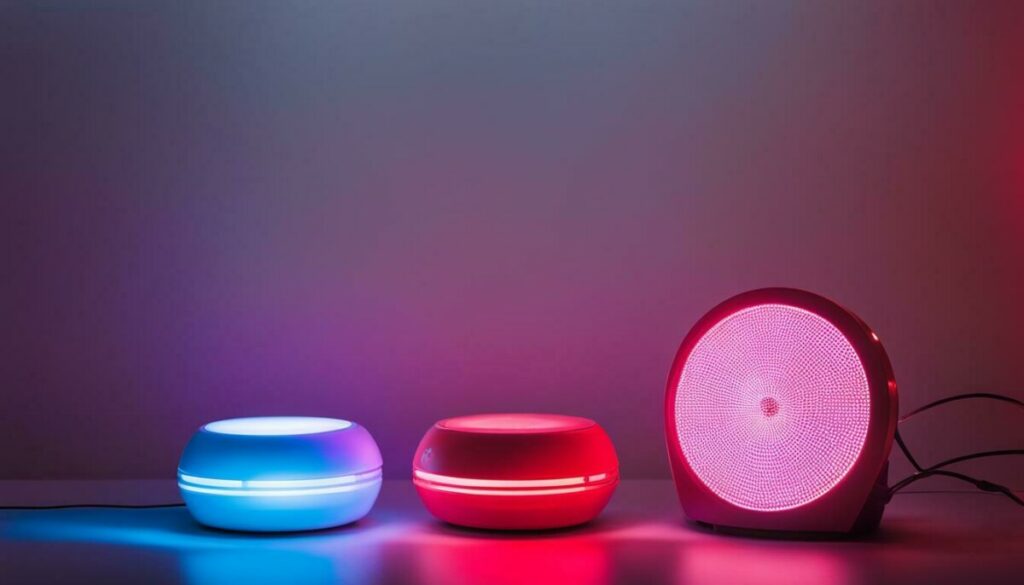
Conclusion
Choosing between blue light therapy and red light therapy can be a tricky decision, but understanding their benefits and mechanisms can help you make an informed choice. While blue light therapy is known for its potential to improve sleep quality, eye health, and skin conditions, red light therapy has shown promise in promoting hair growth and relieving pain.
Ultimately, the therapy you choose will depend on your individual needs and goals. For those looking to improve their skin, selecting the right therapy should be based on specific skin conditions and their severity. For sleep disorders, blue light therapy may be the more effective option. For those experiencing pain, red light therapy may provide relief.
The Future of Light Therapy
The future of light therapy is promising with ongoing research and advancements in the field. Potential developments may include more targeted therapies and customized treatments based on individual needs. Whatever the future holds, light therapy is a valuable addition to many people’s daily routines for enhancing overall well-being.
Incorporating Light Therapy into Your Routine
Now that you’ve chosen the right therapy for your needs, incorporating it into your daily routine is essential. Whether it’s for skin, sleep, hair growth, pain relief, or eye health, consistency is key. It’s important to follow the recommended guidelines and stay committed to seeing the desired results.
Overall, incorporating light therapy into your routine can be a game-changer for improving your physical and mental health. Don’t hesitate to consult a healthcare professional before starting any new treatments, especially if you have underlying medical conditions or are taking prescription medications.
With the right therapy and proper application, light therapy can offer significant benefits and become an essential part of your self-care routine.
FAQ
What is blue light therapy?
Blue light therapy involves the use of specific wavelengths of blue light to target various skin concerns and improve sleep quality.
What is red light therapy?
Red light therapy utilizes specific wavelengths of red light to provide a range of skincare and health benefits.
What are the benefits of blue light therapy?
Blue light therapy can help improve sleep quality, promote eye health, and address certain skin concerns.
What are the benefits of red light therapy?
Red light therapy can stimulate hair growth, relieve pain, and offer skincare benefits.
How do blue light therapy and red light therapy compare?
Both therapies have unique benefits, but the choice between them depends on individual needs and goals.
Which therapy is better for treating acne?
Both blue light therapy and red light therapy have shown effectiveness in treating acne, but results may vary for each individual.
Can light therapy help with depression?
Light therapy, including both blue light therapy and red light therapy, has been used as a complementary treatment for certain types of depression.
Is blue light therapy safe for the eyes?
Blue light therapy can be beneficial for eye health when used properly and within recommended exposure limits.
How effective is red light therapy for hair growth?
Red light therapy has shown promise in stimulating hair growth, but individual results may vary.
Is blue light therapy suitable for addressing sleep disorders?
Blue light therapy has been studied for its potential to improve sleep quality and regulate the sleep-wake cycle.
Which therapy is recommended for pain relief?
Red light therapy has been studied for its analgesic effects and may offer relief for various types of pain.
How can I incorporate light therapy into my routine?
It’s important to follow the recommended usage guidelines and incorporate light therapy into your skincare or health routine consistently for optimal results.

